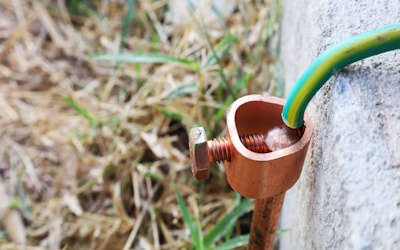Understanding Electrical Grounding
Figure 1: Grounding system in an industrial setting
Electrical grounding is an essential safety feature in power systems, designed to protect against electric shock and equipment damage. It provides a safe path for excess current to dissipate into the earth, preventing hazardous voltages from arising. This article explains the concept of electrical grounding, its importance, and its implementation in various electrical systems.
Table of contents
- How electrical grounding works
- Determining if an appliance/system is grounded
- Key components of grounding
- Grounding applications
- FAQs
How electrical grounding works
Electrical grounding establishes an effective route for discharging electric current, commonly directing the current into the earth to neutralize it. Without grounding, an electric charge could accumulate in wires or devices to dangerously high levels, potentially causing electrical arcing.
The Earth has a negative charge, which can cancel positive charges. This characteristic allows the ground to act as a sink for excess electrical energy, providing a natural discharge point. Most electrical systems (e.g., car batteries, electrical sockets, and domestic appliances) incorporate a grounding wire. This grounding wire is intentionally designed to connect to the earth, taking advantage of the ground's capacity to dissipate surplus electric charge.
Determining if an appliance/system is grounded
- Appliances featuring a three-wire cord and a corresponding three-prong plug have a grounding mechanism—the third wire and prong establish a connection between the appliance's metal frame and the electrical wiring system's grounding.
- To verify the grounding status of an electrical system, inspect the power outlets; an outlet with three prongs typically indicates a three-wire system, where one wire is dedicated to grounding.
Figure 2: Electrical ground symbol
Key components of grounding
Different components work together to form an integrated grounding system that provides safety for people and equipment.
- Grounding electrode: This is a conductive material with direct contact to the earth. It could be a metal rod driven into the ground, a metal plate buried in the soil, or even a buried metal water pipe. The purpose of the grounding electrode is to provide a physical connection to the earth, which acts as a reference point for the electrical system and a sink for fault currents.
- Grounding electrode conductor (GEC): This conductor, or wire, connects the grounding electrode to the grounding system. It is typically made of copper or aluminum and must be appropriately sized to safely carry potential fault currents from the electrical system to the grounding electrode.

Figure 3: Ground wire connecting the grounding electrode to the system.
- Grounding conductor: The grounding conductor connects the non-current-carrying metal parts of electrical equipment (such as the housing of a motor) to the system's grounding electrode conductor or directly to the grounding electrode
- Ground bus: In electrical panels, the ground bus is a conductive bar to which all grounding conductors are connected. It is a central point for the grounding system and is connected to the grounding electrode conductor, ensuring a solid path to earth.
Figure 4: Grounding bus bar terminal
- Bonding: Bonding involves connecting all metallic non-current-carrying parts of an electrical system (such as metal conduit, junction boxes, and enclosures) to the grounding system. This ensures no potential differences between conductive parts, reducing the risk of electric shock.
Grounding applications
Each grounding application is tailored to the specific risks and requirements of the environment it serves, but the underlying principle is the same: to provide a safe and effective path for electrical currents to the earth.
- Industrial grounding: In industrial settings, grounding is fundamental for the safety and functionality of high-powered machinery and electrical systems. Industrial grounding must adhere to stringent standards, such as those outlined by IEEE 141 (the Red Book), to protect against electrical hazards, ensure the continuity of service, and maintain system stability. Robust grounding systems in these environments often include multiple grounding electrodes and extensive bonding to handle the potentially high fault currents and electromagnetic interference.
- Off-grid solar panel systems: Grounding in off-grid solar systems is essential for preventing electrical shocks and protecting equipment from lightning strikes and static discharge. Specific grounding requirements for these systems involve grounding the metal frames of solar panels and any exposed conductive surfaces to prevent electrical buildup. Components such as grounding rods and bonding all the metallic parts ensure a continuous path to the earth, which is critical for off-grid installations that operate independently from the utility grid.
- Home grounding: Residential grounding systems protect inhabitants from electric shocks and electrical fires. Home grounding usually includes grounding rods connected to the service panel and using ground fault circuit interrupters (GFCIs) in areas with high moisture, like bathrooms and kitchens. Outlets in modern homes are typically three-pronged, indicating the presence of a grounding conductor. This setup ensures that any fault current is directed safely into the ground rather than through a person or creating a fire hazard.
Figure 5: A ground fault circuit interrupter
FAQs
What does grounding mean in electricity?
Grounding means connecting an electrical circuit or device to the earth, using a conductor to provide a reference voltage level and a safe path for excess current to dissipate in the event of a fault.
Why does electricity go to the ground?
The ground provides a conductive path with relatively low resistance, allowing excess electricity, such as from a lightning strike or fault in an electrical system, to safely dissipate into the earth and reduce the risk of electric shock or fire.
What electrical systems require grounding?
Most electrical systems require grounding, including residential and commercial power distribution systems, electrical appliances, and electronic equipment, to ensure safety and proper operation.




